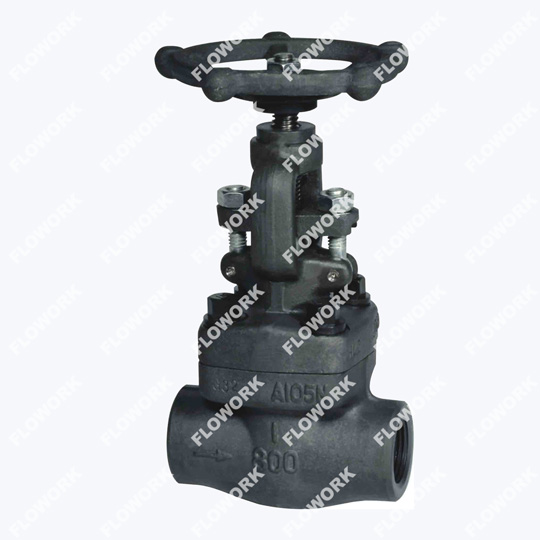
1、You are in restricted area and need password. Please Contact us to obtain documents.
2、PasswordIf you have any questions about quotation or cooperation, please feel free to send us inquiry. Inquiry us
| Size: | 1/2"-2" |
| Pressure: | 150LB-2500LB |
| Body Material: | A105, F304, F304L, F316, F316L, LF1, LF2, LF3, LF9, F51, F53, F11, F22, etc. |
| Seal Material: | STELLITE, 13Cr, SS304, SS316, etc. |
| Connection Type: | Flanged, Butt welded |
| Operation: | Handwheel, gear operated, pneumatic, motorized |
| Face to Face Dimension: | ASME B16.10 |
| Flange End Dimension: | ASME B16.5 |
| Butt Welded Dimension: | ASME B16.25 |
| Design and Manufacture: | API 602 |
| Test Standard: | API 598,API 6FA, ISO 15848-1-2 |
Material can be forged carbon steel, stainless steel, special alloy steel, bronze, etc.
Bolted bonnet, welded bonnet, and pressure self bonnet are available.
Simple structure, small pipe diameter and installing space
Applicable with flange connection, BW connection, SW connection, and NPT connection
Only allow the medium to flow in one direction
To repair a globe valve:
1.Safety: Ensure proper safety measures and equipment are in place, including shutting off the fluid supply and relieving pressure. api 6d ball valve
2.Disassembly: Carefully dismantle the valve, noting the order of removal and the position of components.
3.Inspection: Examine parts for wear, damage, or corrosion. Focus on the seat, disc, stem, and packing.
4.Replace Parts: Depending on the issue, replace damaged parts with manufacturer-approved replacements. Ensure proper fit and compatibility. forged ball valve
5.Lubrication: Lubricate stem and packing with appropriate lubricant to ensure smooth movement and sealing.
6.Reassembly: Reassemble the valve in the reverse order of disassembly, aligning components correctly.
7.Tighten and Adjust: Gradually tighten gland nut to recommended torque to achieve proper packing compression without over-tightening.
8.Pressure Test: Test valve's sealing and function by slowly increasing pressure to its rated level, checking for leaks.
9.Reinstallation: If removed, install the valve back into the pipeline using proper gaskets and fasteners. carbon steel gate valves
10.Operational Test: Operate the valve through its range to ensure smooth movement and correct flow control.
Note: Consult manufacturer guidelines and consider professional assistance if uncertain about any step.
To replace a globe valve:
1.Preparation: Turn off supply, release pressure, and prepare tools and materials.
2.Disassembly: If needed, remove old valve parts following safe disassembly practices. high temperature gate valves
3.Disconnect: Unscrew or cut old valve from pipes, ensuring clean pipe ends.
4.Sealing: Apply thread sealant or tape to new valve's threads.
5.Installation: Position new valve, align connections, and hand-tighten.
6.Tighten: Use wrenches to securely tighten valve connections, avoiding over-tightening.
7.Reassemble: Reassemble valve components, following manufacturer's guidelines.
8.Testing: Turn on supply, check for leaks, and operate valve to ensure proper function, low temperature ball valves.
9.Final Checks: Verify no leaks, smooth operation, and system integrity.
10.Cleanup: Dispose of debris, tidy work area, and ensure safety.
Note: Always follow manufacturer instructions and consider seeking professional help if unsure.
A pneumatic globe valve is a type of control valve used to regulate the flow of fluids, gases, or air in a system using compressed air as the driving force. It operates by controlling the position of a movable plug or disc inside the valve body to modulate the flow rate, api602 forged gate valve.
The valve's design includes an actuator that converts the energy from compressed air into mechanical motion. When air pressure is applied to the actuator, it moves the valve's closure element (plug or disc) against or away from the flow path, thus controlling the flow rate. Adjusting the air pressure allows precise control over the valve's opening and closing positions, enabling accurate flow regulation.
Pneumatic globe valves find applications in industries requiring fine-tuned control, such as manufacturing, process automation, chemical processing, and HVAC systems. Their advantages include fast response times, suitability for remote operation, and the ability to integrate into larger control systems. However, they require a source of compressed air, proper air quality control, and periodic maintenance for optimal performance.
Send us a message if you have any questions or request a quote.

A reply from our experts within 24 hours

The latest detailed product catalugue

One-stop service for your project